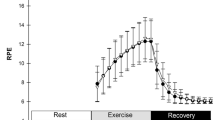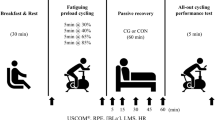Abstract
Sporting compression garments (CG) are used widely during exercise despite little evidence of benefits. The purpose of this study was to investigate coverage and pressure effects of full-body CG on cardiovascular and thermoregulatory function at rest and during prolonged exercise, and on exercise performance. Twelve recreationally trained male cyclists [mean (SD) age, 26 (7) years; \( \dot{V}{\text{O}}_{2\max } \), 53 (8) mL kg−1 min−1] completed three sessions (counterbalanced order), wearing either correctly-sized CG (CSG; 11–15 mmHg), over-sized CG (OSG; 8–13 mmHg), or gym shorts (CONT). Test sessions were conducted in temperate conditions [24 (1)°C, 60 (4)% relative humidity; ~2 m s−1 air velocity during exercise], consisting of resting on a chair then on a cycle ergometer, before 60-min fixed-load cycling at ~65% \( \dot{V}{\text{O}}_{2\max } \) and a 6-km time trial. Wearing CG (CSG or OSG) did not mitigate cardiovascular strain during mild orthostatic stress at rest (p = 0.20–0.93 for garment effects). During exercise, cardiac output was ~5% higher in the CG conditions (p < 0.05), which appears to be accounted for via non-significant higher end-exercise heart rate (~4–7%, p = 0.30; p = 0.06 for greater heart rate drift in CSG); other cardiovascular variables, including stroke volume, were similar among conditions (p = 0.23–0.91). Covered-skin temperature was higher in CG conditions (p < 0.001) but core (oesophageal) temperature was not (p = 0.79). Time-trial performance (mean power, time taken) was similar with or without CG (p = 0.24–0.44). In conclusion, any demonstrable physiological or psychophysical effects of full-body CG were mild and seemingly reflective more of surface coverage than pressure. No benefit was evident for exercise performance.


Similar content being viewed by others
References
Agu O, Baker D, Seifalian AM (2004) Effect of graduated compression stockings on limb oxygenation and venous function during exercise in patients with venous insufficiency. Vascular 12:69–76
Ali A, Caine MP, Snow BG (2007) Graduated compression stockings: physiological and perceptual responses during and after exercise. J Sports Sci 25:413–419
Ali A, Creasy R, Edge J (2010) Physiological effects of wearing graduated compression stockings during running. Eur J Appl Physiol 109:1017–1025
Berry MJ, McMurray RG (1987) Effects of graduated compression stockings on blood lactate following an exhaustive bout of exercise. Am J Phys Med 66:121–132
Bochmann RP, Seibel W, Haase E, Hietschold V, Rödel H, Deussen A (2005) External compression increases forearm perfusion. J Appl Physiol 99:2337–2344
Borg GAV (1982) Psychophysical bases of perceived exertion. Med Sci Sports Exerc 14:377–381
Bringard A, Denis R, Belluye N, Perrey S (2006a) Effects of compression tights on calf muscle oxygenation and venous pooling during quiet resting in supine and standing positions. J Sports Med Phys Fit 46:548–554
Bringard A, Perrey S, Belluye N (2006b) Aerobic energy cost and sensation responses during submaximal running exercise—positive effects of wearing compression tights. Int J Sports Med 27:373–378
British Standards Institution (1990) BS 7209: water vapour permeable apparel fabrics. British Standards Institution, London
British Standards Institution (1998) BS EN 12127: textiles—fabrics—determination of mass per unit area using small samples. British Standards Institution, London
British Standards Institution (1999) BS EN 12751: textiles—sampling of fibres, yarns and fabrics for testing. British Standards Institution, London
Chatard JC, Atlaoui D, Farjanel J, Louisy F, Rastel D, Guézennec CY (2004) Elastic stockings, performance and leg pain recovery in 63-year-old sportsmen. Eur J Appl Physiol 93:347–352
Coleridge Smith PD, Hasty JH, Scurr JH (1991) Deep vein thrombosis: effect of graduated compression stockings on distension of the deep veins of the calf. Br J Surg 78:724–726
Duffield R, Portus M (2007) Comparison of three types of full-body compression garments on throwing and repeat-sprint performance in cricket players. Br J Sports Med 41:409–414
Duffield R, Edge J, Merrells R, Hawke E, Barnes M, Simcock D, Gill N (2008) The effects of compression garments on intermittent exercise performance and recovery on consecutive days. Int J Sports Physiol Perform 3:454–468
Goh S, Laursen P, Dascombe B, Nosaka K (2010) Effect of lower body compression garments on submaximal and maximal running performance in cold (10°C) and hot (32°C) environments. Eur J Appl Physiol. doi:10.1007/s00421-010-1705-2
Gore SE, Laing RM, Wilson CA, Carr DJ, Niven BE (2006) Standardizing a pre-treatment cleaning procedure and effects of application on apparel fabrics. Text Res J 76:455–464
Groothuis JT, van Vliet L, Kooijman M, Hopman MTE (2003) Venous cuff pressures from 30 mmHg to diastolic pressure are recommended to measure arterial inflow by plethysmography. J Appl Physiol 95:342–347
Higgins T, Naughton GA, Burgess D (2009) Effects of wearing compression garments on physiological and performance measures in a simulated game-specific circuit for netball. J Sci Med Sport 12:223–226
Houghton LA, Dawson B, Maloney SK (2009) Effects of wearing compression garments on thermoregulation during simulated team sport activity in temperate environmental conditions. J Sci Med Sport 12:303–309
Ibegbuna V, Delis KT, Nicolaides AN, Aina O (2003) Effect of elastic compression stockings on venous hemodynamics during walking. J Vasc Surg 37:420–425
International Organization for Standardization (1993) ISO 11092: textiles—physiological effects—measurement of thermal and water-vapour resistance under steady-state conditions (sweating guarded-hotplate test). International Organization for Standardization, Geneva
International Organization for Standardization (1995a) ISO 9237: textiles–determination of the permeability of fabrics to air. International Organization for Standardization, Geneva
International Organization for Standardization (1995b) ISO 10551: ergonomics of the thermal environment—assessment of the influence of the thermal environment using subjective judgement scales. International Organization for Standardization, Geneva
International Organization for Standardization (1996) ISO 5084: textiles—determination of thickness of textiles and textile products. International Organization for Standardization, Geneva
International Organization for Standardization (2000a) ISO 6330: textiles—domestic washing and drying procedures for textile testing. International Organization for Standardization, Geneva
International Organization for Standardization (2000b) ISO 9073-6: textiles—test methods for nonwovens—Part 6: absorption. International Organization for Standardization, Geneva
International Organization for Standardization (2004) ISO 9886: ergonomics—evaluation of thermal strain by physiological measurements. International Organization for Standardization, Geneva
International Organization for Standardization (2005) ISO 139: textiles—standard atmospheres for conditioning and testing. International Organization for Standardization, Geneva
Johnson JM, Rowell LB (1975) Forearm skin and muscle vascular responses to prolonged leg exercise in man. J Appl Physiol 39:920–924
Jonker MJ, de Boer EM, Adèr HJ, Bezemer PD (2001) The oedema-protective effect of Lycra® support stockings. Dermatology 203:294–298
Kemmler W, Stengel Sv, Köckritz C, Mayhew J, Wassermann A, Zapf J (2009) Effect of compression stockings on running performance in men runners. J Strength Cond Res 23:101–105
Kraemer WJ, Bush JA, Newton RU, Duncan ND, Volek JS, Denegar CR, Canavan P, Johnston J, Putukian M, Sebastianelli WJ (1998) Influence of a compression garment on repetitive power output production before and after different types of muscle fatigue. Sports Med Training Rehabil 8:163–184
Kraemer WJ, Volek JS, Bush JA, Gotshalk LA, Wagner PR, Gómez AL, Zatsiorsky VM, Duzrte M, Ratamess NA, Mazzetti SA, Selle BJ (2000) Influence of compression hosiery on physiological responses to standing fatigue in women. Med Sci Sports Exerc 32:1849–1858
Lawrence D, Kakkar VV (1980) Graduated, static, external compression of the lower limb: a physiological assessment. Br J Surg 67:119–121
Liu R, Lao T, Kwok Y, Li Y, Ying M (2008) Effects of graduated compression stockings with different pressure profiles on lower-limb venous structures and haemodynamics. Adv Ther 25:465–478
Lord RSA, Hamilton D (2004) Graduated compression stockings (20–30 mmHg) do not compress leg veins in the standing position. ANZ J Surg 74:581–585
MacRae BA, Cotter JD, Laing RM (2011) Compression garments and exercise: garment considerations, physiology, and performance. Sports Med (in press)
Mayrovitz HN, Delgado M (1996) Effect of compression bandaging on lower extremity skin microcirculation. Wounds 8:200–206
Mayrovitz HN, Larsen PB (1997) Effects of compression bandaging on leg pulsatile blood flow. Clin Physiol 17:105–117
Mayrovitz HN, Sims N (2003) Effects of ankle-to-knee external pressures on skin blood perfusion under and distal to compression. Adv Skin Wound Care 16:198–202
Mekjavic IB, Rempel ME (1990) Determination of esophageal probe insertion length based on standing and sitting height. J Appl Physiol 69:376–379
Mitchell JW, Nadel ER, Stolwijk JA (1972) Respiratory weight losses during exercise. J Appl Physiol 32:474–476
Privett SE, George KP, Whyte GP, Cable NT (2010) The effectiveness of compression garments and lower limb exercise on post-exercise blood pressure regulation in orthostatically intolerant athletes. Clin J Sport Med 20:362–367
Rimaud D, Calmels P, Roche F, Mongold J, Trudeau F, Devillard X (2007) Effects of graduated compression stockings on cardiovascular and metabolic responses to exercise and exercise recovery in persons with spinal cord injury. Arch Phys Med Rehabil 88:703–709
Santee WR, Gonzalez RR (1988) Characteristics of the thermal environment. In: Pandolf KB, Sawka MN, Gonzalez RR (eds) Human performance physiology and environmental medicine at terrestrial extremes. Benchmark Press Inc, Indianapolis, pp 1–43
Scanlan AT, Dascombe BJ, Reaburn PRJ, Osborne M (2008) The effects of wearing lower-body compression garments during endurance cycling. Int J Sports Physiol Perform 3:424–438
Siegel S, Castellan NJ (1988) Nonparametric statistics for the behavioral sciences. McGraw-Hill, New York
Sigel B, Edelstein AL, Savitch L, Hasty JH, Felix WR (1975) Type of compression for reducing venous stasis: a study of lower extremities during inactive recumbency. Arch Surg 110:171–175
Sparrow RA, Hardy JG, Fentem PH (1995) Effect of ‘antiembolism’ compression hosiery on leg blood volume. Br J Surg 82:53–59
Sperlich B, Haegele M, Achtzehn S, Linville J, Holmberg H-C, Mester J (2010) Different types of compression clothing do not increase sub-maximal and maximal endurance performance in well-trained athletes. J Sports Sci 28:609–614
Sperlich B, Haegele M, Krüger M, Schiffer T, Holmberg H-C, Mester J (2011) Cardio-respiratory and metabolic responses to different levels of compression during submaximal exercise. Phlebology 26:102–106
Stenger MB, Brown AK, Lee SMC, Locke JP, Platts SH (2010) Gradient compression garments as a countermeasure to post-spaceflight orthostatic intolerance. Aviat Space Environ Med 81:883–887
Sugawara J, Tanabe T, Miyachi M, Yamamoto K, Takahashi K, Iemitsu M, Otsuki T, Homma S, Maeda S, Ajisaka R, Matsuda M (2003) Non-invasive assessment of cardiac output during exercise in healthy young humans: comparison between Modelflow method and Doppler echocardiography method. Acta Physiol Scand 179:361–366
Watanuki S, Murata H (1994) Effects of wearing compression stockings on cardiovascular responses. Ann Physiol Anthropol 13:121–127
Zar JH (1984) Biostatistical analysis 2nd edition. Prentice-Hall, Englewood Cliffs
Acknowledgments
We are thankful to Nigel Barrett, Dene Irvine, and Clare Nicholls for technical assistance, to Sport and Recreation New Zealand (specifically Richard Young) for supplying the garments, and to the participants for their commitment. The authors declare they have no conflicts of interest.
Conflict of interest
The authors declare they have no conflicts of interest.
Author information
Authors and Affiliations
Corresponding author
Additional information
Communicated by Narihiko Kondo.
Rights and permissions
About this article
Cite this article
MacRae, B.A., Laing, R.M., Niven, B.E. et al. Pressure and coverage effects of sporting compression garments on cardiovascular function, thermoregulatory function, and exercise performance. Eur J Appl Physiol 112, 1783–1795 (2012). https://doi.org/10.1007/s00421-011-2146-2
Received:
Accepted:
Published:
Issue Date:
DOI: https://doi.org/10.1007/s00421-011-2146-2




